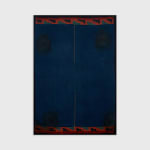Huari Culture 100 AD-1200 AD
Tunic (with Red Stepped Border), Circa. 600 AD
Camelid fibres
174 x 122 cm
68'5" x 48" in.
68'5" x 48" in.
HUA0005
Copyright of Paul Hughes Fine Arts
Further images
A most subtle yet alluring example of Nazca/Huari tunic with a deeply saturated indigo blue field and polychromatic border. There is a ritually applied coloration applied to the 4 corners...
A most subtle yet alluring example of Nazca/Huari tunic with a deeply saturated indigo blue field and polychromatic border.
There is a ritually applied coloration applied to the 4 corners of the indigo central field which indicated a ceremonial use by a Shaman or member of the élites.
There is a ritually applied coloration applied to the 4 corners of the indigo central field which indicated a ceremonial use by a Shaman or member of the élites.
Exhibitions
Our North is the South, Bergamin & Gomide, Sao Paulo (2021)Confluences in South American Art, Cork Street no.9, London (2022)
Publications
Confluences in Art, 2019. Page. 61Our North is the South, Bergamin & Gomide, 2021. Page 23
Join our mailing list
* denotes required fields
We will process the personal data you have supplied in accordance with our privacy policy (available on request). You can unsubscribe or change your preferences at any time by clicking the link in our emails.







